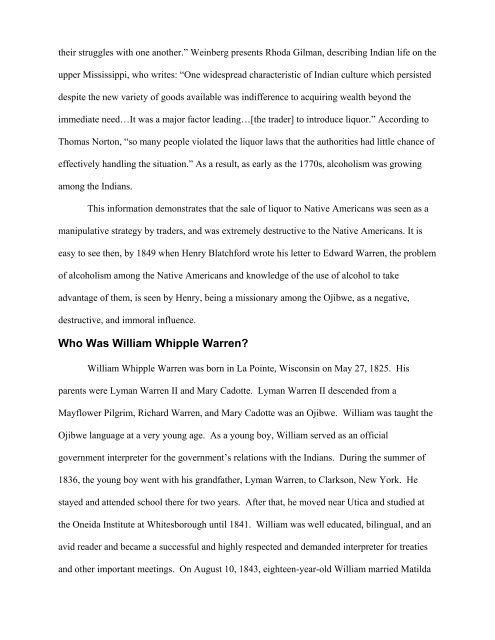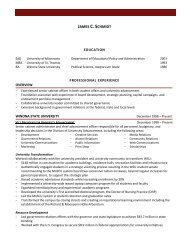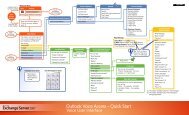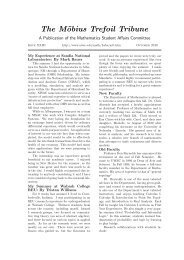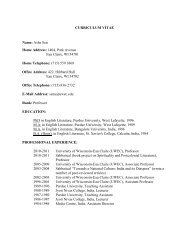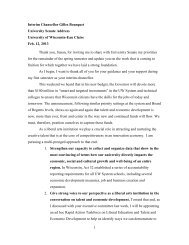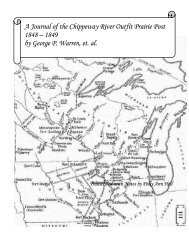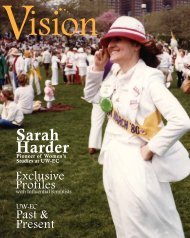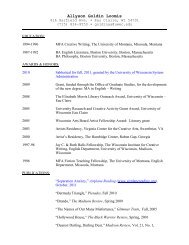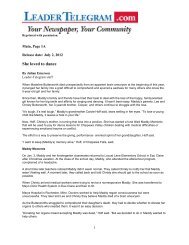Manuscript Project Transcription and Works Cited for Research of ...
Manuscript Project Transcription and Works Cited for Research of ...
Manuscript Project Transcription and Works Cited for Research of ...
You also want an ePaper? Increase the reach of your titles
YUMPU automatically turns print PDFs into web optimized ePapers that Google loves.
their struggles with one another.” Weinberg presents Rhoda Gilman, describing Indian life on the<br />
upper Mississippi, who writes: “One widespread characteristic <strong>of</strong> Indian culture which persisted<br />
despite the new variety <strong>of</strong> goods available was indifference to acquiring wealth beyond the<br />
immediate need…It was a major factor leading…[the trader] to introduce liquor.” According to<br />
Thomas Norton, “so many people violated the liquor laws that the authorities had little chance <strong>of</strong><br />
effectively h<strong>and</strong>ling the situation.” As a result, as early as the 1770s, alcoholism was growing<br />
among the Indians.<br />
This in<strong>for</strong>mation demonstrates that the sale <strong>of</strong> liquor to Native Americans was seen as a<br />
manipulative strategy by traders, <strong>and</strong> was extremely destructive to the Native Americans. It is<br />
easy to see then, by 1849 when Henry Blatch<strong>for</strong>d wrote his letter to Edward Warren, the problem<br />
<strong>of</strong> alcoholism among the Native Americans <strong>and</strong> knowledge <strong>of</strong> the use <strong>of</strong> alcohol to take<br />
advantage <strong>of</strong> them, is seen by Henry, being a missionary among the Ojibwe, as a negative,<br />
destructive, <strong>and</strong> immoral influence.<br />
Who Was William Whipple Warren?<br />
William Whipple Warren was born in La Pointe, Wisconsin on May 27, 1825. His<br />
parents were Lyman Warren II <strong>and</strong> Mary Cadotte. Lyman Warren II descended from a<br />
Mayflower Pilgrim, Richard Warren, <strong>and</strong> Mary Cadotte was an Ojibwe. William was taught the<br />
Ojibwe language at a very young age. As a young boy, William served as an <strong>of</strong>ficial<br />
government interpreter <strong>for</strong> the government’s relations with the Indians. During the summer <strong>of</strong><br />
1836, the young boy went with his gr<strong>and</strong>father, Lyman Warren, to Clarkson, New York. He<br />
stayed <strong>and</strong> attended school there <strong>for</strong> two years. After that, he moved near Utica <strong>and</strong> studied at<br />
the Oneida Institute at Whitesborough until 1841. William was well educated, bilingual, <strong>and</strong> an<br />
avid reader <strong>and</strong> became a successful <strong>and</strong> highly respected <strong>and</strong> dem<strong>and</strong>ed interpreter <strong>for</strong> treaties<br />
<strong>and</strong> other important meetings. On August 10, 1843, eighteen-year-old William married Matilda


